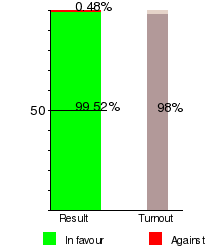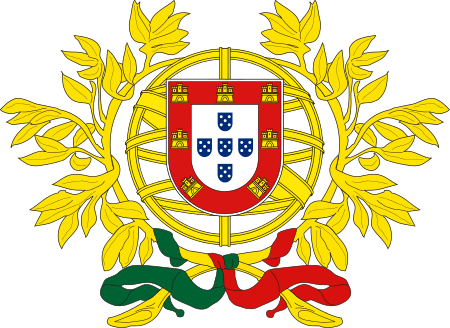1933 Portuguese constitutional referendum
The Portuguese constitutional referendum was held on 19 March 1933. A draft of the Constitution had been published one year before and the public was invited to state any objections in the press.[1] These tended to stay in the realm of generalities and only a handful of people, less than 6,000, voted against the new constitution.[1] With its passage, women were allowed to vote for the first time in Portugal and given a voice in the National Assembly.[2] Secondary education was a requirement for women suffrage, while men needed only to be able to read and write.

 |
|---|
| This article is part of a series on the politics and government of Portugal |
| Constitution |
|
|
Legislature
|
|
|
|
According to a dispatch from the British Embassy in Lisbon, prior to the referendum: "Generally speaking, this novel constitution is receiving the marked approval which it deserves. It has a certain Fascist quality in its theory of 'corporations', which is a reversion to medieval from the 18th-century doctrines. But this quality, unsuited to our Anglo-Saxon tradition, is not out of place in a country which has hitherto founded its democracy on a French philosophy and found it unsuited to the national temperament". The British Embassy also pointed out that Portugal's illiteracy made elections difficult and illusory.[3]
The constitutional referendum was held on 19 March 1933.[4] The new constitution was approved by 99.5% of voters,[5] in a referendum in which abstentions were counted as support votes.[6] It institutionalised the Estado Novo one party state led by António de Oliveira Salazar, and provided for a directly elected and President and National Assembly with a four-year term.[6]
There have been conflicting accounts of the results of the referendum. Michael Derrick, in 1938, gives 1,292,864 Yes; 6,090 against; 660 spoilt and 30,654 abstentions 30,654.[7] Colonel Clement Egerton, in 1943, provides the same names as Derrick.[8] Peter Fryer and Patricia McGowan Pinheiro state that official figures were 580,376 in favour; 5,406 against and 11,528 abstentions.[9] Hugh Kay provides, in 1970, 719,364 favour; 5,955 against; 488,840 abstentions in a registered electorate of 1,214,159, in line with the results published in the Diário de Notícias of March 20, 1933.[10]
Fryer and McGowan Pinheiro state that the Constitution was railroaded through not letting more than a handful of people vote "no" but the authors do not explain how the potential "no" voters were restrained.[1] What is quite clear is that abstention numbers where high.[1] Hugh Kay points out that abstention might have been due to the fact that voters were presented with a package deal to which they had to say "yes" or "no" with no opportunity to accept one clause and reject the other. [1]
In this referendum women were allowed to vote for the first time in Portugal -The women's right to vote had not been obtained during the First Republic, despite feminist claims – however secondary education was a requirement for their suffrage, while men needed only to be able to read and write.[11]
Results
| Choice | Votes | % |
|---|---|---|
| 1,292,864 | 99.52 | |
| No | 6,190 | 0.48 |
| Valid votes | 1,299,054 | 99.95 |
| Invalid or blank votes | 666 | 0.05 |
| Total votes | 1,299,720 | 100.00 |
| Registered voters and turnout | 1,330,258 | 97.70 |
| Source: Nohlen & Stöver | ||
Sources
- Kay, Hugh (1970). Salazar and Modern Portugal. NY, USA: Hawthorn Books. LCCN 73-115919.CS1 maint: ref=harv (link)
- "Oficial Plebescit Results - Diario do Governo 11 de Abril de 1933" (PDF). Díário da República Eletrónico. Díário da República,Portugal. April 11, 1933. Retrieved 27 September 2015.
References
- Kay 1970, p. 49.
- Áurea Adão and José Remédios, "The educational narrativity in the first period of Oliveira Salazar’s government. Women’s voices in the National Assembly (1935–1945)," History of Education (2005) 34#5 pp 547-559.
-
- "British Embassy in Lisbon despatch on draft constitution". Contemporary Portuguese History Online. The Contemporary Portuguese History Research Centre. Archived from the original on 18 May 2018. Retrieved 26 September 2015.
- Dieter Nohlen & Philip Stöver (2010) Elections in Europe: A data handbook, p1542 ISBN 978-3-8329-5609-7
- Nohlen & Stöver, p1551
- Nohlen & Stöver, p1535
- Derrick, Michael; R.J. Stove (1938). The Portugal of Salazar. New York: Campion Books, Ltd. p. 117.
- Egerton, F. Clement C. Egerton (1943). Salazar, Rebuilder of Portugal. London: Hodder & Stoughton. p. 194.CS1 maint: ref=harv (link)
- Freyer, Peter; McGowan Pinheiro, Patricia (1961). Oldest Ally: a Portrait of Salazar's Portugal (1st ed.). London: Dennis Dobson. p. 116.
- "Diário de Notícias March 20, 1933". Diário de Notícias. Archived from the original on 7 September 2014. Retrieved 27 September 2015.
- Adão, Áurea; Remédios, Maria José (23 May 2006). "The educational narrativity in the first period of Oliveira Salazar's government. Women's voices in the National Assembly (1935–1945)". History of Education: Journal of the History of Education Society. 34 (5): 547–559. doi:10.1080/00467600500221315.
External links
- "1933 Political Constitution of the Portuguese Republic". Contemporary Portuguese History Online. The Contemporary Portuguese History Research Centre. Archived from the original on 27 September 2018. Retrieved 26 September 2015.
- Final tabulation of the results of the plebiscite Diário da República